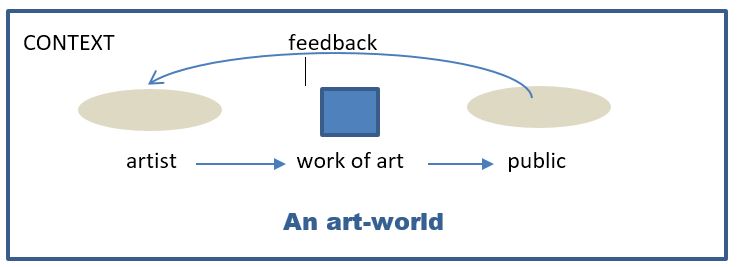Artworld and “art-worlds”
In our Western world and for many valid reasons, more and more people are practising the visual arts. Undoubtedly we are inundated with paintings of all sorts, excellent, good, mediocre and simply bad. But what makes a work of art “excellent”? There are so many answers and it all depends on the artist’s own “art-world”.
But what is an art-world? There are two concepts for this term: first there is Arthur Danto’s “Artworld” with a capital “A”, and then mine, the hyphenated “art-world” (we will get to it later). Danto’s “Artworld” is a community of artists, knowledgeable critics, art curators, big collectors intimately associated with important art museums and galleries. In 1964, Danto wrote : “The artworld stands to the real world in something like the relationship in which the City of God stands to the Earthly City. Certain objects, like certain individuals, enjoy a double citizenship, but there remains, […] a fundamental contrast between artworks and real objects.”1 In order to comprehend the works produced in this “artworld”, one “requires something the eye cannot decry – an atmosphere of artistic theory, a knowledge of the history of art.” Having said this, I am drafting this simple diagram;

There is an artist who produces a work of art to be appreciated by the public. In other words, we have an emitter, a message and a receptor, therefore, the basic schema of communication. The public reacts in a way or another, hence the notion of “feedback”, which will nourish the artist in one way or the other. All these elements compositing this diagram (oval, square, arrows) belong to a “context”. If this diagram refers to Danto’s “Artworld”, the context here would belong to New York City since it is where we find the top American museums, galleries, art critics, artists, collectors, etc. It could also be London, Paris or Kassel. Now to my concept of “art-world”.
Mine is linked to geography, mediology and socio-psychology. My “art-world” is a well-circumscribed territory endowed of its own system of transmission devices needed for the circulation of ideas. This system comprises, airports, train stations, roads, sidewalks, libraries, churches, mosques, synagogues, museums, galleries, schools, universities, periodicals, restaurants, cafés, colleges, etc. Through this system, may it be complex or simple, travels the many ideas of “art”. Having said this, take a pencil, and describe your own immediate art-world. Where do you live? How long have you been there? How many museums and galleries? Any libraries? A bus terminal? An airport? An art association? An art school? An orchestra? A hospital? A periodical of some kind? All these questions will, of course, define your “art-world”, the “art-world” to which you contribute.
There are hundreds of art-worlds, “contexts” in America. San Francisco, South Bend’s, Grosse Pointe, Great Falls (see top map), Penfield etc. And all these art-worlds have their own images, their own art discussions, their own exhibition walls, their own visions. Since Danto considers that only an exclusive segment of the public has the power to “make” a work of art, “making” in the sense of “reckoning”, he leaves aside all the art done by the large majority of artists and loved by so many communities. Is he right to say this? And who are we to judge whether an “art-world” is better than another?
Nevertheless, and as said in my last post, life is all about evolution; if society has to evolve, its art too. Now that you are aware of your own “art-world”, it is time to move on to the notion of “idea”.
My following posts will try to explain my understanding of art and its role in society. By doing so, it will also clarify the way we instruct during our painting workshops in Tuscany, the reason why we have, at Walk the Arts, so many returnees.
1-Arthur C. Danto, “The Artworld”, The Journal of Philosophy, Volume 61, Issue 19, American Philosophical Association, Eastern Division Sixty-First Annual Meeting (Oct. 15, 1964), 571-584.


Merci Yves
Indeed an interesting topic. There is a definite art world in my area. Artists with different levels of experience in different media routinely meet and “paint” together; one group led by an instructor for a very small fee. We have two excellent galleries which are in constant use requiring booking 2 years in advance for an exhibition. At this particular moment I could be preparing for 3 different themed exhibitions. The area is well known for attracting works from local and further afield artists. In many cases it provides new artists an opportunity to display their work in smaller exhibitions and with a great deal of assistance from their peers and organizers. Critiquing amongst a small group of like minded people becomes very open and well received in all but a few cases. Those few who have difficulty accepting soon learn the value of comments received. I often retell the story of Yves treatment of my less than average painting (i.e. Terrible) when he upturned it and rubbed in onto the grass and then finished it by scrubbing it with a balled up plastic bag……in doing so improved it no end!
I feel that the art world that I am part of feeds the bigger picture art world. What I am learning gives me the understanding of the underlying techniques of the masters. I now view all art works with a more understanding eye; it helps me appreciate what I see, It allows me to perhaps provide better or more informed feedback if asked.
Excellent. You are defining a this moment, your art-world.